- Inicio
- Acerca de nosotros
- Industria
- Servicios
- Leyendo
- Contáctenos
Mercado de Espacios de Arte Virtual 3D: Análisis Actual y Pronóstico (2024-2032)
Énfasis en el tipo (interactivo y no interactivo); aplicación (galerías, museos, exposiciones de arte y otros); y región/país
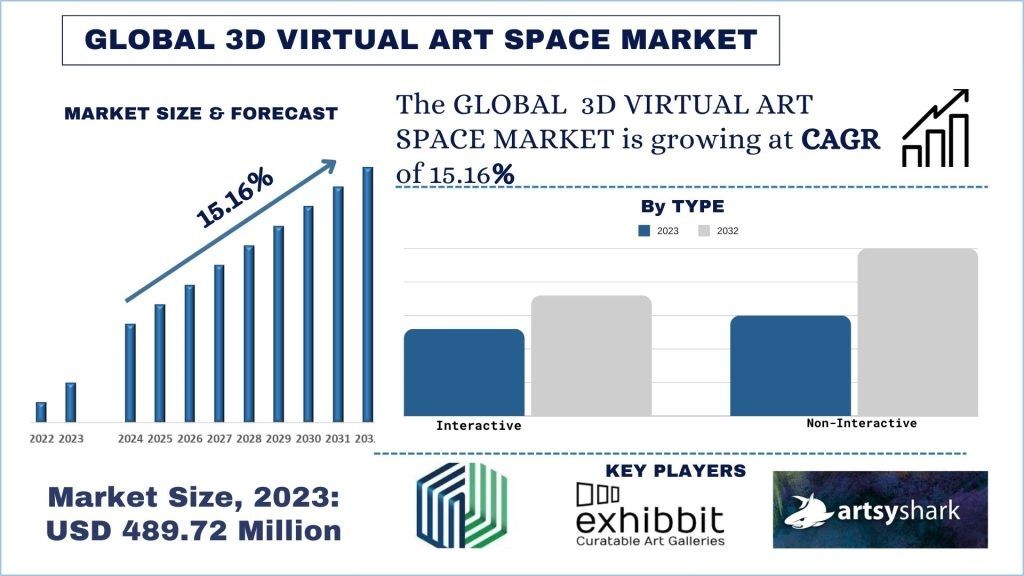
Tamaño y previsión del mercado del espacio de arte virtual 3D
El mercado del espacio de arte virtual 3D se valoró en 489,72 millones de USD y se espera que crezca a una fuerte CAGR de alrededor del 15,16% durante el período de previsión (2024-2032) debido a la creciente proliferación de tecnologías como la realidad virtual y la realidad aumentada.
Análisis del mercado del espacio de arte virtual 3D
Los espacios de arte virtual 3D son galerías de arte y exposiciones digitales que permiten a los artistas mostrar su trabajo en un entorno tridimensional e inmersivo. Estos espacios se crean utilizando realidad virtual (VR) y tecnologías de gráficos por ordenador, lo que permite a los visitantes explorar e interactuar con el arte como si estuvieran físicamente presentes. Se puede acceder a las galerías virtuales 3D en línea desde cualquier parte del mundo, lo que hace que el arte sea más accesible a un público mundial en comparación con las galerías físicas tradicionales.
El rápido desarrollo de la realidad virtual (VR), la realidad aumentada (AR) y otras tecnologías inmersivas ha permitido la creación de entornos de arte 3D altamente realistas e interactivos. Las herramientas avanzadas de software y hardware, como el software de modelado y renderizado 3D, han facilitado a los artistas la creación y exhibición de su trabajo en un entorno virtual. Además, los Millennials y la Generación Z, los grupos de consumidores dominantes en el mercado del arte, tienen una fuerte afinidad por las experiencias digitales e interactivas, lo que demuestra una tendencia de cambio en las preferencias de los consumidores, impulsando el crecimiento de la demanda de espacio de arte virtual 3D. Por ejemplo, según un estudio de Hiscox, el 67% de los coleccionistas de arte millennials prefieren descubrir y comprar arte en línea, lo que indica una creciente demanda de plataformas de arte virtual. Además, el concepto del metaverso, un mundo virtual donde los usuarios pueden interactuar y relacionarse entre sí, está ganando terreno. A medida que los bienes inmuebles virtuales se vuelven más deseables, aumenta la demanda de arte y experiencias virtuales 3D. Factores como estos están contribuyendo significativamente a impulsar la demanda de espacio de arte virtual 3D en todo el mundo.
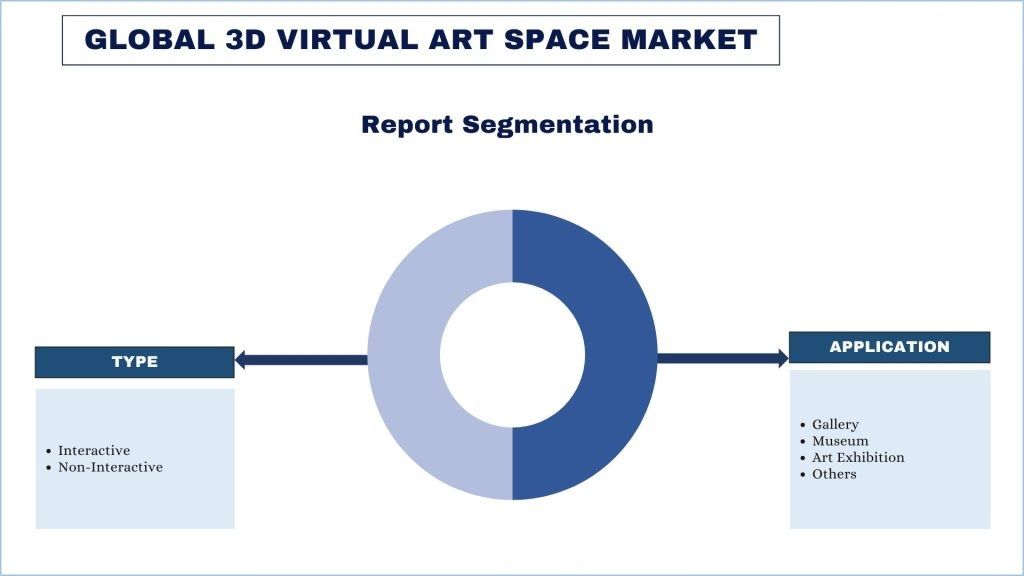
Tendencias del mercado del espacio de arte virtual 3D
Esta sección analiza las tendencias clave del mercado que están influyendo en los diversos segmentos del mercado del espacio de arte virtual 3D, según lo identificado por nuestro equipo de expertos en investigación.
El arte 3D interactivo destaca como un importante contribuyente a la creciente popularidad del mercado del espacio de arte virtual 3D en todo el mundo.
El espacio de arte virtual 3D interactivo domina el mercado general de arte virtual 3D, representando la mayor parte. El dominio puede atribuirse a factores como la mejora de la experiencia del usuario. Las experiencias de arte virtual 3D interactivo permiten a los usuarios interactuar activamente con la obra de arte digital, fomentando una experiencia más inmersiva y atractiva. Los usuarios pueden manipular, explorar e incluso crear sus propias obras de arte virtuales, lo que genera mayores niveles de participación y satisfacción. Además, el rápido progreso en tecnologías como la realidad virtual (VR), la realidad aumentada (AR) y la realidad mixta (MR) ha permitido el desarrollo de entornos de arte virtual 3D altamente interactivos y realistas. Estos avances han hecho posible crear espacios de arte virtuales atractivos y realistas que imitan fielmente el mundo físico. Además, la creciente disponibilidad y asequibilidad de los visores de RV, los teléfonos inteligentes habilitados para la RA y otros dispositivos inmersivos han hecho que las experiencias de arte virtual 3D interactivas sean más accesibles a un público más amplio. Esto ha contribuido a la adopción generalizada y la popularidad de estos espacios de arte interactivos. Estos desarrollos, entre otros, son factores primarios que fomentan un entorno propicio e impulsan la adopción de espacio de arte virtual 3D interactivo en los mercados.
América del Norte emerge como el mercado de más rápido crecimiento y representa una parte importante del mercado del espacio de arte virtual 3D a nivel mundial.
América del Norte se ha convertido en uno de los mercados globales más grandes y de más rápido crecimiento para el arte virtual 3D. América del Norte, particularmente los Estados Unidos, ha estado a la vanguardia del desarrollo tecnológico, con importantes inversiones en investigación y desarrollo. La región tiene un próspero ecosistema tecnológico, con centros como Silicon Valley liderando la carga en el desarrollo de hardware y software de vanguardia para la creación y distribución de arte virtual 3D. Además, los consumidores norteamericanos han sido los primeros en adoptar el arte virtual 3D, impulsados por su interés en las tecnologías emergentes y una creciente apreciación por las experiencias inmersivas e interactivas que ofrece este medio. Esta demanda de los consumidores ha impulsado el crecimiento del mercado del arte virtual 3D, con empresas y artistas respondiendo a esta tendencia. Además, América del Norte alberga algunas de las economías más ricas del mundo, con altos ingresos disponibles que permiten a los consumidores invertir en bienes de lujo, incluido el arte y los objetos de colección. La demografía rica en América del Norte ha estado a la vanguardia de la adopción de nuevas tecnologías, incluido el arte virtual 3D. Por ejemplo, América del Norte tenía un número récord de personas con un alto patrimonio neto de 7,4 millones de personas en 2022, la mayor cantidad del mundo. Por último, el entorno empresarial en América del Norte se caracteriza por un fuerte espíritu empresarial, políticas fiscales favorables y una infraestructura bien establecida. Estos factores han atraído a empresarios, nuevas empresas y empresas establecidas a la región, lo que ha llevado a una proliferación de plataformas y mercados de arte virtual 3D.
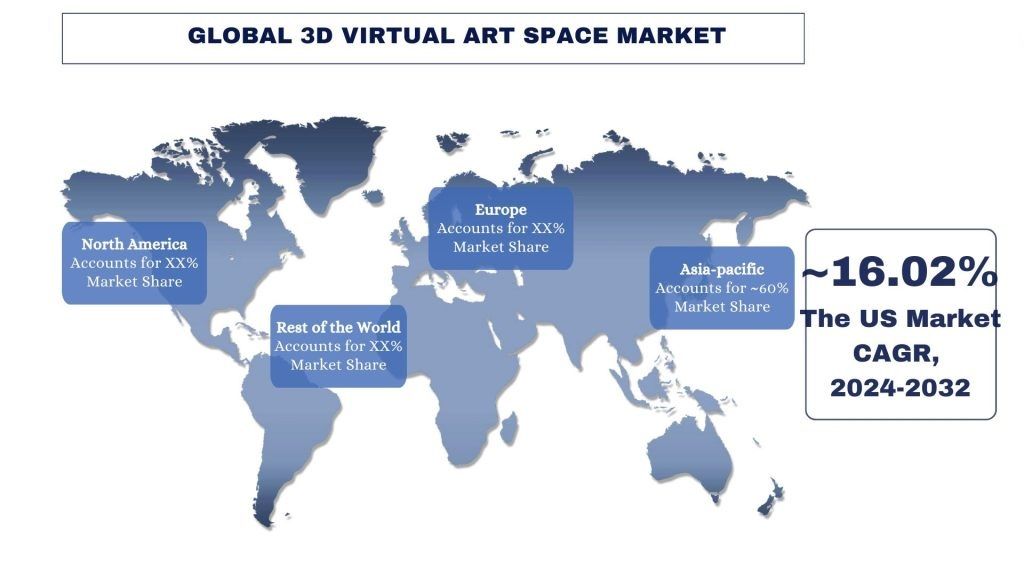
Descripción general de la industria del espacio de arte virtual 3D
El mercado del espacio de arte virtual 3D es competitivo y está fragmentado, con la presencia de varios actores del mercado global e internacional. Los actores clave están adoptando diferentes estrategias de crecimiento para mejorar su presencia en el mercado, como asociaciones, acuerdos, colaboraciones, lanzamientos de nuevos productos, expansiones geográficas y fusiones y adquisiciones. Algunos de los principales actores que operan en el mercado son Dataverse Ltd; exhibbit; ARTSY SHARK; V21 ARTSPACE; Virtual Art Gallery; Emperia; KUNSTMATRIX Technologies GmbH; Vortic Limited; VR-All-Art AG; y ArtGate
Noticias del mercado del espacio de arte virtual 3D
- En febrero de 2024, Apple presentó Vision Pro junto con su innovadora tecnología espacial. Vision Pro representa la primera incursión de Apple en el ámbito de la "computación espacial", integrando a la perfección los entornos del mundo real y digital. Viene equipado con pantallas de primera línea, un nuevo chip potente y funciones avanzadas de captura 3D para experiencias verdaderamente inmersivas. Este ordenador espacial está equipado con una pantalla 3D, una cámara 3D y una funcionalidad de seguimiento ocular.
Cobertura del informe del mercado del espacio de arte virtual 3D
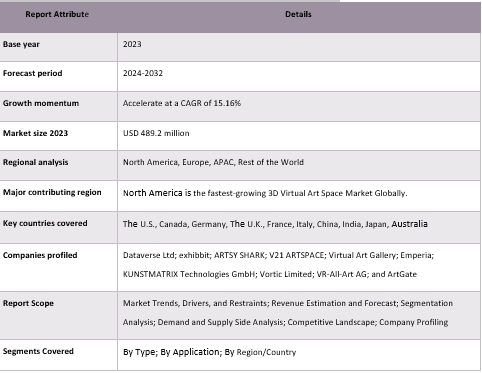
Cobertura del informe del mercado del espacio de arte virtual 3D
Razones para comprar este informe:- El estudio incluye análisis de tamaño y previsión del mercado validados por expertos clave autenticados de la industria.
- El informe presenta una revisión rápida del rendimiento general de la industria de un vistazo.
- El informe cubre un análisis en profundidad de los pares prominentes de la industria con un enfoque principal en las finanzas clave del negocio, las carteras de productos, las estrategias de expansión y los desarrollos recientes.
- Examen detallado de los impulsores, las restricciones, las tendencias clave y las oportunidades que prevalecen en la industria.
- El estudio cubre exhaustivamente el mercado a través de diferentes segmentos.
- Análisis profundo a nivel regional de la industria.
Opciones de personalización:
El mercado global de espacio de arte virtual 3D se puede personalizar aún más según el requisito o cualquier otro segmento de mercado. Además de esto, UMI entiende que puede tener sus propias necesidades comerciales; por lo tanto, no dude en contactarnos para obtener un informe que se adapte completamente a sus requisitos.
Tabla de contenido
Metodología de Investigación para el Análisis del Mercado de Espacios de Arte Virtual 3D (2024-2032)
El análisis del mercado histórico, la estimación del mercado actual y la previsión del mercado futuro del mercado global de Espacios de Arte Virtual 3D fueron los tres pasos principales realizados para crear y analizar la adopción de espacios de arte virtual 3D en las principales regiones a nivel mundial. Se llevó a cabo una exhaustiva investigación secundaria para recopilar las cifras históricas del mercado y estimar el tamaño actual del mercado. En segundo lugar, para validar estos conocimientos, se tomaron en consideración numerosos hallazgos y supuestos. Además, también se realizaron exhaustivas entrevistas primarias con expertos de la industria en toda la cadena de valor del mercado global de Espacios de Arte Virtual 3D. Después de la suposición y la validación de las cifras del mercado a través de entrevistas primarias, empleamos un enfoque de arriba hacia abajo/de abajo hacia arriba para pronosticar el tamaño completo del mercado. Posteriormente, se adoptaron métodos de desglose del mercado y triangulación de datos para estimar y analizar el tamaño del mercado de los segmentos y subsegmentos de la industria. La metodología detallada se explica a continuación:
Análisis del Tamaño del Mercado Histórico
Paso 1: Estudio en Profundidad de Fuentes Secundarias:
Se llevó a cabo un estudio secundario detallado para obtener el tamaño histórico del mercado de Espacios de Arte Virtual 3D a través de fuentes internas de la empresa, como informes anuales y estados financieros, presentaciones de rendimiento, comunicados de prensa, etc., y fuentes externas que incluyen revistas, noticias y artículos, publicaciones gubernamentales, publicaciones de la competencia, informes del sector, bases de datos de terceros y otras publicaciones creíbles.
Paso 2: Segmentación del Mercado:
Después de obtener el tamaño histórico del mercado de Espacios de Arte Virtual 3D, realizamos un análisis secundario detallado para recopilar información histórica del mercado y compartirla para diferentes segmentos y subsegmentos para las principales regiones. Los principales segmentos, como el tipo y la aplicación, se incluyen en el informe. Además, se realizaron análisis a nivel de país para evaluar la adopción general de modelos de prueba en esa región.
Paso 3: Análisis de Factores:
Después de adquirir el tamaño histórico del mercado de diferentes segmentos y subsegmentos, realizamos un análisis de factores detallado para estimar el tamaño actual del mercado de Espacios de Arte Virtual 3D. Además, realizamos un análisis de factores utilizando variables dependientes e independientes, como el tipo y la aplicación del mercado de Espacios de Arte Virtual 3D. Se llevó a cabo un análisis exhaustivo de los escenarios de oferta y demanda teniendo en cuenta las principales asociaciones, fusiones y adquisiciones, la expansión comercial y los lanzamientos de productos en el sector del mercado de Espacios de Arte Virtual 3D en todo el mundo.
Estimación y Previsión del Tamaño Actual del Mercado
Tamaño Actual del Mercado: Basándonos en información práctica de los 3 pasos anteriores, llegamos al tamaño actual del mercado, los actores clave en el mercado global de Espacios de Arte Virtual 3D y las cuotas de mercado de los segmentos. Todos los porcentajes de participación requeridos y los desgloses del mercado se determinaron utilizando el enfoque secundario mencionado anteriormente y se verificaron a través de entrevistas primarias.
Estimación y Previsión: Para la estimación y previsión del mercado, se asignaron ponderaciones a diferentes factores, incluidos los impulsores y las tendencias, las restricciones y las oportunidades disponibles para las partes interesadas. Después de analizar estos factores, se aplicaron técnicas de previsión relevantes, es decir, el enfoque de arriba hacia abajo/de abajo hacia arriba, para llegar a la previsión del mercado para 2032 para diferentes segmentos y subsegmentos en los principales mercados a nivel mundial. La metodología de investigación adoptada para estimar el tamaño del mercado abarca:
- El tamaño del mercado de la industria, en términos de ingresos (USD) y la tasa de adopción del mercado de Espacios de Arte Virtual 3D en los principales mercados a nivel nacional
- Todos los porcentajes de participación, divisiones y desgloses de los segmentos y subsegmentos del mercado
- Actores clave en el mercado global de Espacios de Arte Virtual 3D en términos de productos ofrecidos. Además, las estrategias de crecimiento adoptadas por estos actores para competir en el mercado de rápido crecimiento.
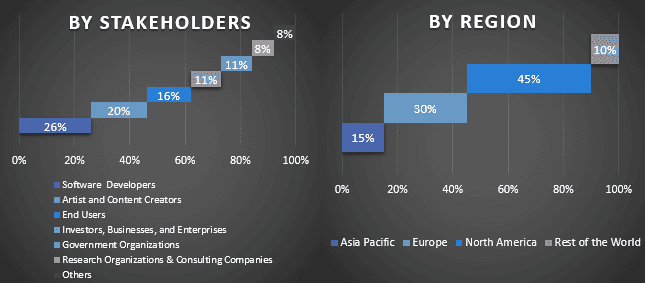
Gráfico del Mercado de Espacios de Arte Virtual 3D
Validación del Tamaño y la Cuota de Mercado
Investigación Primaria: Se realizaron entrevistas en profundidad con los Líderes de Opinión Clave (KOL), incluidos los Ejecutivos de Alto Nivel (CXO/VP, Jefe de Ventas, Jefe de Marketing, Jefe de Operaciones, Jefe Regional, Jefe de País, etc.) en las principales regiones. Los hallazgos de la investigación primaria se resumieron y se realizó un análisis estadístico para probar la hipótesis establecida. Los aportes de la investigación primaria se consolidaron con los hallazgos secundarios, convirtiendo así la información en información práctica.
División de Participantes Primarios en Diferentes Regiones
Ingeniería de Mercado
Se empleó la técnica de triangulación de datos para completar la estimación general del mercado y llegar a números estadísticos precisos para cada segmento y subsegmento del mercado global de Espacios de Arte Virtual 3D. Los datos se dividieron en varios segmentos y subsegmentos después de estudiar varios parámetros y tendencias en las áreas de tipo y aplicación en el mercado global de Espacios de Arte Virtual 3D.
El objetivo principal del Estudio del Mercado Global de Espacios de Arte Virtual 3D
Las tendencias actuales y futuras del mercado del mercado global de Espacios de Arte Virtual 3D se identificaron en el estudio. Los inversores pueden obtener información estratégica para basar su criterio para las inversiones en el análisis cualitativo y cuantitativo realizado en el estudio. Las tendencias actuales y futuras del mercado determinaron el atractivo general del mercado a nivel regional, proporcionando una plataforma para que el participante industrial explote el mercado sin explotar para beneficiarse de una ventaja de ser el primero en actuar. Otros objetivos cuantitativos de los estudios incluyen:
- Analizar el tamaño actual y previsto del mercado de Espacios de Arte Virtual 3D en términos de valor (USD). Además, analizar el tamaño actual y previsto del mercado de diferentes segmentos y subsegmentos.
- Los segmentos en el estudio incluyen áreas de tipo y aplicación
- Definir y analizar el marco regulatorio para el Espacio de Arte Virtual 3D
- Analizar la cadena de valor involucrada con la presencia de varios intermediarios, junto con el análisis de los comportamientos de los clientes y la competencia de la industria
- Analizar el tamaño actual y previsto del mercado de Espacios de Arte Virtual 3D para la región principal
- Los principales países de las regiones estudiadas en el informe incluyen Asia Pacífico, Europa, América del Norte y el resto del mundo
- Perfiles de empresas del mercado de Espacios de Arte Virtual 3D y las estrategias de crecimiento adoptadas por los participantes del mercado para mantenerse en el mercado de rápido crecimiento.
- Análisis regional en profundidad de la industria
Preguntas frecuentes Preguntas frecuentes
P1: ¿Cuál es el tamaño actual del mercado y el potencial de crecimiento del mercado global de Espacios de Arte Virtual 3D?
P2: ¿Cuáles son los factores impulsores del crecimiento del mercado global de Espacios de Arte Virtual 3D?
P3: ¿Qué segmento posee la mayor parte del mercado global de Espacios de Arte Virtual 3D por Tipo?
P4: ¿Cuáles son las tecnologías y tendencias emergentes en el mercado global del espacio de arte virtual 3D?
P5: ¿Qué región será el mercado de Espacio de Arte Virtual 3D global de más rápido crecimiento?
P6: ¿Quiénes son los actores clave en el mercado global de Espacios de Arte Virtual 3D?
Relacionados Informes
Los clientes que compraron este artículo también compraron










